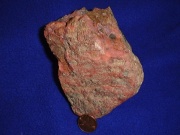Mercury
Description
A silvery liquid, metallic element that occurs naturally in the form of Cinnabar (HgS). Mercury deposits occur worldwide with an abundance of 0.5 ppm in the earth's crust. Mercury is commercially mined in China, Italy, Mexico, Canada, the Philippines, Peru, Spain, and Russia. Metallic mercury is obtained by roasting cinnabar. The heavy liquid metal has been found in Egyptian tombs of 1500 BCE (Scott 1991). Mercury forms alloys, called amalgams, with most metals except Iron and Platinum. It is used for Amalgam gilding of Gold and the silvering of mirrors. When pure, mercury rarely tarnishes with the exception of some oxidation that occurs when it is exposed to warm moist air. Liquid mercury is used in thermometers, barometers, mercury vapor lamps, and the manufacture of mercury salts. It was formerly used for dental fillings and for the treatment of syphilis. Mercury vapor can be present in cabinets containing native mercury (Waller 1999) as well as those cases containing specimens treated with Mercuric chloride (a common insecticide and fungicide from the 19th century).
Mercury is on the ILFI Red list of building materials.
Synonyms and Related Terms
Hg; quicksilver; hydrargyrum (Lat.); Kwik (Ned.); mercure (Fr.); Quecksilber (Deut.); mercurio (It., Esp.); mercúrio (Port.); Kvicksilver (Sven.); liquid silver
Risks
- Highly toxic by inhalation and skin absorption.
- Poisoning causes inflammation of the mouth, muscle spasms and excess saliva.
- Mercury vapors can react with gold and silver to form amalgams.
- ThermoFisher: SDS
Physical and Chemical Properties
Reacts with nitric acid and hot concentrated sulfuric acid. Does not react with dilute hydrochloric acid or alkalis. Insoluble in water, ethanol and ether. Soluble in lipids.
Diphenylcarbazone solution is used for the colorimetric detection of mercury salts.
| Composition | Hg (atomic no. 80) |
|---|---|
| CAS | 7439-97-6 |
| Melting Point | -38.87 C |
| Density | 13.534 g/ml |
| Molecular Weight | atomic wt = 200.59 |
| Boiling Point | 356.72 C |
Resources and Citations
- D.Scott, Metallography and Microstructure of Ancient and Historic Metals, Getty Conservation Institute, 1991.
- O. Untracht, Metal Techniques for Craftsmen, Doubleday and Co., Garden City, NY, 1968.
- R.Waller, "Internal Pollutants, Risk Assessment and Conservation Priorities" ICOM Preprints, Lyon, France, 1999. p. 113-118.
- Web Elements: Website
- R. Mayer, The Artist's Handbook of Materials and Techniques, Viking Press, New York, 1981
- Michael McCann, Artist Beware, Watson-Guptill Publications, New York City, 1979
- Dictionary of Building Preservation, Ward Bucher, ed., John Wiley & Sons, Inc., New York City, 1996
- The Merck Index, Martha Windholz (ed.), Merck Research Labs, Rahway NJ, 10th edition, 1983 Comment: entry 5967
- Encyclopedia Britannica, http://www.britannica.com Comment: "mercury." Accessed 9 Dec. 2004 .
- G.S.Brady, Materials Handbook, McGraw-Hill Book Co., New York, 1971 Comment: p. 502
- Richard S. Lewis, Hawley's Condensed Chemical Dictionary, Van Nostrand Reinhold, New York, 10th ed., 1993
- Van Nostrand's Scientific Encyclopedia, Douglas M. Considine (ed.), Van Nostrand Reinhold, New York, 1976
- Random House, Webster's Encyclopedic Unabridged Dictionary of the English Language, Grammercy Book, New York, 1997
- The American Heritage Dictionary or Encarta, via Microsoft Bookshelf 98, Microsoft Corp., 1998
